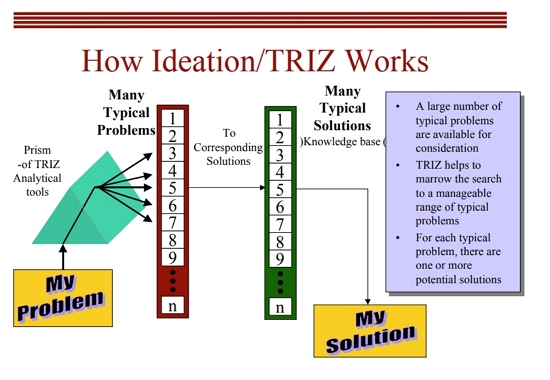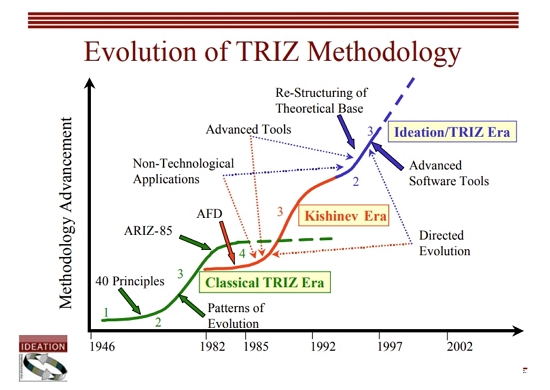I-TRIZ: The Next Big Thing?
The I-TRIZ method for promoting technological innovation and Inventive Engineering
Published in Hebrew in
Status - Management
Thinking Magazine August 1998
By Dr. Yoni Mizrachi, Organizational and Strategic Consultant,
ZOOZ
The I-TRIZ method is a systematic methodology for promoting technological innovation and inventive engineering. It combines knowledge bases with a range of software tools intended for problem definition and solution, and for supporting development processes. The uniqueness of this approach, compared with other methods based on psychology and management theory (such as brainstorming), is that the Ideation-TRIZ approach is based on empirical research and on findings in areas of engineering sciences and technology.
What is TRIZ and what does it do?
If you feel that your are nearing the end of a long and expensive development race and your competitors are about to pass you and win a brand name and profitable chunks of the market before you do; if it seems to you that innovation efforts in your organization are not systematic enough and are based on chance flashes of 'genius,' 'apples falling down,' and 'water overflowing the bathtub'; if you sense that your R&D people are sated and have settled down to middle-class complacency, and the flow of ideas and innovation is not what it was; if your company has an excellent product which, 'if we could only solve that problem,' would conquer the world; if you are certain that reducing development time, production costs, and product price by fifteen percent would make your firm and your product a winner; or if despite all the ISO and procedures, the cancer of 'it'll be okay' and improvisation has taken a grip on your firm, and this is something you are unwilling to accept; then the article before you has several ideas that are certain to interest you.
The competitive business environment at the end of the millennium is grounded in a new set of economic rules based on information, knowledge, learning, and technological innovation. The almost obsessive preoccupation of companies and organizations with management methods and new work techniques may be explained only in evolutionary terms, namely as an attempt by the organism (firms and organizations) at adaptation to the changing business ecology. In economics, as in nature, a cultivated organism such as humans and organizations can alter itself in the course of its life without waiting for long-term hereditary genetic processes. The initiative for the change and the decision on how to change, and into what, is in the hands of the individuals and the organizations. Those capable of adapting optimally to the new rules of the business ecology will flourish. Those not are likely sooner or later to become extinct. This plethora of strategies for adaptation and survival is now joined by something that may be a methodology, or perhaps a theory, or possibly a science, which is gradually shaping up as 'the next big thing.' It's called TRIZ: an acronym for Russian words for theory of creative/inventive problem solving, and in a world where companies wrap up their products with more intelect than material, TRIZ is on the verge of becoming a compulsory standard.

The uniqueness of the approach, compared with other methods based on psychology and management theory (such as brainstorming), is that modern TRIZ (henceforth, I-TRIZ) is founded on over fifty years of R&D in areas of engineering sciences and technology in which time over two million patents were studied from all across the globe and in all known domains of engineering; the goal was to identify and refine recurrent principles and to formulate them as a series of rules and structures transmissible across domains by means of computerized knowledge bases and software. The software may be defined as a combination of decision support systems (DSS) and expert systems, and they are fed by the thousands of generic technological principles arranged and connected in the knowledge base which is primed for intuitive and friendly use. Accordingly, the link of the I-TRIZ method to managerial and psychological theories and models is primarily complementary, but it seems that its relevance to contemporary technology-based business ecology is much greater.
The I-TRIZ method is a systematic methodology to promote technological innovation and inventive engineering that combines knowledge bases with a range of software tools intended for problem definition and solution, and for supporting development processes. The method is studied at several universities in the world and is followed by leading companies in the United States, Japan, and Europe. In the automobile industry, it operates in giant companies such as GM, Ford, Chrysler, Toyota, Dana, Rockwell, and TRW; in the communications and electronics industry it is applied at Motorola, Honeywell, and Nortel; in petrochemicals it is used by such companies as Amoco, Dow, and Eastman; in the field of consumer products it is used at Xerox, Kodak, and Proctor & Gamble; and in aviation it is applied in foremost companies such as McDonnell Douglas, Allied Signal, Boeing, NASA, and Lockheed. In addition, the method has been used with the land and air forces of the American military.
From the strategic-management perspective, correct application and embedding of the system lead to significant acceleration and improved efficiency of R&D processes, significant reduction in time to market, and a general and rapid rise in value of the firm's intellectual capital through registration of patents and copyright, and earlier identification of the firm's products as brand names. Furthermore, as we shall see later, the very application of the method can serve as a lever for more profound changes in business processes associated with the work culture and with protection and development of the organization's intellectual capital.
From the engineering perspective, the method may be seen as a thinking tool and as a repository of applicable knowledge leading to intensification of the professional capabilities of the Subject Matter Expert and to systematic exploitation of the professional and intellectual potential in the technical development, production, and support teams. The target audience that has to keep abreast of developments in the sphere includes CEOs, start-up companies, development managers, venture capital fund managers, production managers, industry and administration managers, product managers, engineers, inventors, and technological/engineering entrepreneurs.
In this article we shall briefly review the history of the method and explain the principles of the theory behind it. On this foundation we shall discuss the main methodological tools for applying the method and the strategic-managerial implications involved in and deriving from its application.
Origins of the TRIZ approach and the transition to the I-TRIZ approach
The history of the TRIZ approach is no less colorful and fascinating than its intellectual aesthetics. The 'W. Edwards Deming' (TQM) of I-TRIZ is Genrich Altshuller, and in 1946 he fired the first round in a huge intellectual effort by hundreds of researchers and thousands of students, an effort whose outcome is the present incarnation of TRIZ, namely Ideation/TRIZ (I-TRIZ). Already at age 14, Altshuller had won recognition as an inventor by virtue of a device he developed for underwater breathing. On account of his talents as an inventor he was recruited to serve in the Soviet fleet a patent tester, and during those years in which he assessed and studied thousands of patents he began his life's work: identification of recurrent principles and patterns characterizing inventive engineering thinking. The systematic study of these principles, he thought, could lead to more rapid and efficient application of inventive engineering solutions. He considered invention ability inherent in every person, if only he or she were trained to think and to use the right tools. A letter of concern he wrote to Stalin in 1948 led to a year of interrogation and torture, at the end of which he was sentenced to 25 years' imprisonment. In the frozen North of Russia jail the first TRIZ research institute budded. Surrounded by intellectuals, engineers, artists, and scientists, Altshuller continued to develop the theory, and shortly after the death of Stalin in 1953 he was freed from prison. Two years later Altshuller's first publication on TRIZ appeared. As the years passed, with some advances and setbacks the method was applied in the Soviet Union to thousands of technological problems and in almost all the known spheres of engineering and science. Mainly for political reasons, in certain years occupation with the method went underground, and was studied by small groups of intellectuals - Altshuller's pupils, with whom he never hesitated to generously share the knowledge and theory he had developed. Altshuller published 14 books and wrote hundreds of articles on TRIZ subjects. He studied over 200,000 patents, of which he identified about 40,000 as representing the most effective solutions in almost every domain. In his work he established the classical era as a foundation for what was to follow.

A number of his outstanding pupils, headed by one of them, Boris Zlotin, founded in Kishinev in the early 1980s a research institute engaged in the continued intensive development of the theory and its application on a commercial footing. In 1992, an engineer and well-to-do businessman entered the picture, an Israeli long domiciled in the United States called Zion Bar-El. He heard of the method, became enthusiastic about it, and as in fairytales he purchased the research institute in Kishinev with all its scientists and intellectual capital, and transferred it to Detroit, the capital of the American automobile industry; there, orders and projects from several leading companies in the branch were already waiting.
The steadily accumulated experience about the way western economy works, combined with limited capital resources and time for development, allowed the team of scientists concentrated in Detroit to elevate the method to new and startling theoretical and practical levels. In recent years, the method has been augmented by dozens of additional engineering principles, more efficient work methods than the classical development, and new and original thinking and practical tools (especially in systems' failure forecasting (AFD) and directed evolution of product development). The entire approach has been geared to work in harmony with the new business ecology of contemporary information economy: a real-time economy, hungry for technological innovation; an economy in which, as the great guru of the management Tom Peters argues, a new product must get one response by its customers: 'Wow!' The software tools for defining problems and the all-embracing computerized knowledge bases developed by the American Ideation company under the leadership of Zlotin, Zusmann and their colleagues, have magnified the method and advanced it so far that the we now talk of the Ideation/TRIZ (I-TRIZ) method, which constitutes a huge leap forward as compared with the classical TRIZ approach.





